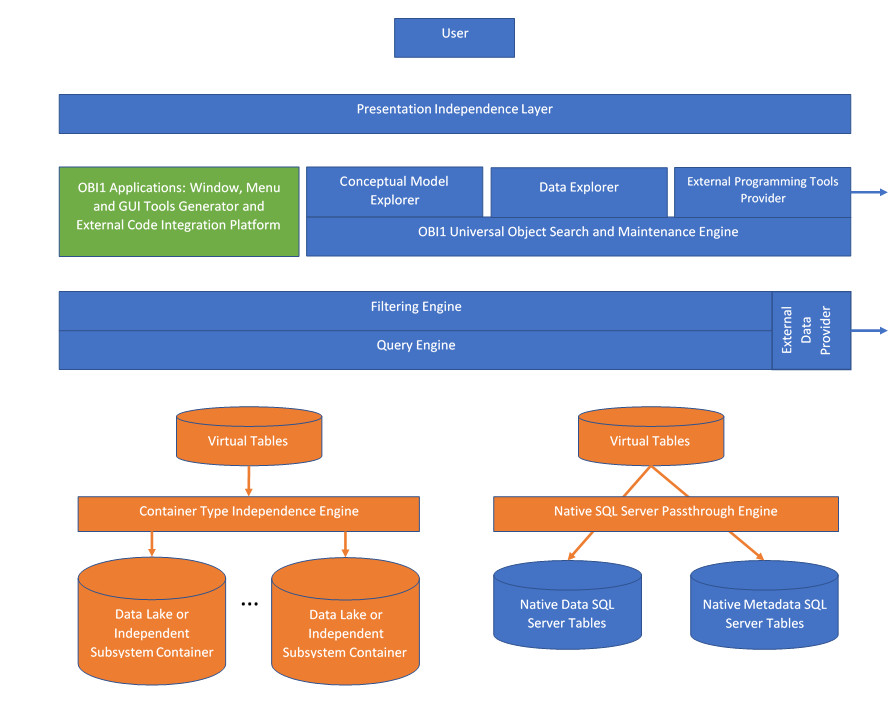|
|
Object Business Intelligence 1 (OBI1)
Our unique Conceptual Model Builder and Software Development Platform
What is OBI1?
The OBI1 Functionality

OBI1 (Object Business Intelligence 1) is an Information Systems Conceptual Model Development platform that creates an all-encompassing, enterprise-wide, object model,
which is subsequently used as the foundation to provide different key tools and information to users of all the different user-profiles in the organization.
These are the key advantages of using OBI1:
-
Building and maintaining an enterprise-wide Conceptual Model, easily accessible and understandable to both, technical users and non-technical decision makers.
OBI1 is the ultimate reference repository for everyone involved in the decision making, development, maintenance, modification and extension of the enterprise
information system.
-
Integration of existing diverse components of the enterprise information system into a single platform, that allows visibility of all the data across the
multiple subsystems, including the ability to query data across subsystems and the implementation of operational interfaces between different components of
the enterprise information system.
-
OBI1 provides visibility to non-technical information consumers, allowing them to browse data, by graphically creating object-oriented queries that join
data across dissimilar subsystems, with no need for programming new software or new database queries by technical staff. This frees valuable technical staff
from day-to-day tasks related to providing individual non-technical users with specific sets of ad-hoc or recurrently needed data views. This also speeds up
the overall response to those requests for information from non-technical users, avoiding many of those requests falling perpetually into the proverbial
"back burner".
-
OBI1 provides a development platform for programmers, analysts and software architects, allowing them to create new software code that can be easily
integrated into the overall enterprise information system, in a controlled, secure and bug free environment. OBI1 provides the programmers and analysts with
precompiled Object Classes that can be easily and safely be invoked when writing code.
-
OBI1 comes with a set of Standard Business Objects Classes, coming from different toolkits that are delivered with the basic standard product, and accepts
the incorporation of new toolkits, that can be either developed in-house, or acquired from Aboard Software or other independent suppliers. OBI1 is an ideal
platform for third party software suppliers to produce OBI1 toolkits, to deliver software tools to software developer teams. Some examples of the toolkits
provided with the OBI1 basic standard product are:
- The aERP ERP Toolkit
- The Aboard CRM Toolkit
- The Web Portal (B2B) and Store (B2C) Toolkit
-
OBI1 provides non-programmer users with the ability to develop new subsystems without the need to write software code. Using the OBI1 Conceptual Model
Object Classes, non-technical users that have a cabal understanding of a new subsystem to be developed, can interactively and intuitively develop an entire
subsystem with a full set of menus, screens, reports, object queries, and subsystem-specific object classes without having any programming expertise.
The new subsystem can use the existing OBI1 Conceptual Model Object Classes to, elegantly and effortlessly, integrate the new subsystem into the existing
enterprise information system.
-
OBI1 can act as a data provider for some complex subsystems, like machine learning or big data applications, freeing their developers from the need to focus
on the details of the platforms that contain the information to be used.
-
OBI1 provides the backbone structure that describes the overall structure of a Data Lake and the relationship between dissimilar isolated components of the
overall enterprise information system. Furthermore, OBI1 opens the use of the information contained in the Data Lake to non-technical users, allowing them to
graphically and interactively create object queries to find the information they need across the many independent and non-connected subsystems that contribute
information to the Data Lake. All this can happen without engaging any programmers or writing any new software code.
OBI1 is a tool designed for the Information Systems Architects, who in the OBI1 context are not expected to be persons with knowledge about programming or software
development techniques, but rather persons with a deep understanding of what the information needs of their enterprise are and what the functionality and data contents
of the Information Systems of their enterprise should be.
Before going into a more formal description of OBI1, we present a few typical cases in which OBI1 can be a unique and decisive tool for the information systems
architects, developers, implementers and managers:
-
An enterprise that needs to develop and implement a new customized Information System or Application, like a new ERP for example.
-
An enterprise with a complex Information System built from multiple subsystems and information tools, that needs to consolidate the entire framework into
a Conceptual Model, using OBI1 as the tool to build that Conceptual Model and also as a single source tool to gain access to the data contained in the
different components of the entire framework.
-
An enterprise that needs to extend or customize an existing Information System or Application, like an existing ERP for example.
-
An enterprise with a complex Information System built from multiple subsystems and information tools, that already implemented a Data Lake for their
framework, and that needs to build a Conceptual Model for it, using OBI1 as the tool to build that Conceptual Model and also as a single source tool to gain
access to the data contained in the Data Lake.
OBI1 Serves Users with Different Profiles
-
OBI1 users do not need to have any technical programming expertise, users with a good understanding of the information needs of their enterprise can use OBI1 to:
-
Gain visibility over the structure of the overall Conceptual Model of the enterprise and over how its different parts integrate or provide
functionality to that Conceptual Model.
-
Gain visibility over all the data contained in the enterprise information system.
-
Implement new Information Systems or Subsystems without the need to write software code.
-
Extend existing Information Systems or Subsystems without the need to write software code.
-
OBI1 is an invaluable tool for Information Systems experts that need to implement, extend, maintain, by eventually writing new software code or modifying
existing software code, or to simply make decisions about existing complex Information Systems and Subsystems.
The OBI1 Tool
Description of OBI1 as a tool:
-
OBI1 is useful in organizations that either:
-
Need to implement an entire Information System or Application subsystems.
-
Have in place Information Systems with multiple separate subsystems, that possibly do not integrate with each other. For them, OBI1 acts as a tool
to integrate the different subsystems into a single Conceptual Object Model framework that provides visibility over the overall complex Information
System structure, as well as over the data it contains in the different subsystems.
-
Have already implemented a data lake that relies on multiple, separate, nonintegrated subsystems, because it provides the conceptual model framework
that opens the structure and the data contents of the data lake interactively to non-technical users.
-
OBI1 does not require that software code is written, but when convenient, will seamlessly integrate software code written by the users, providing a development
framework that integrates with the most popular software development platforms.
-
OBI1 allows organizations to build, maintain, and provide general and non-qualified visibility of, the Conceptual Model of the overall Information Systems
framework of the enterprise.
-
OBI1 allows organizations to define the different object classes that are the components of the Conceptual Model of the enterprise, as well as the
interrelations between those object classes.
-
OBI1 allows organizations to describe existing or planned complex Information Systems and Applications, allowing users to develop entire systems or
subsystems, to extend existing systems or subsystems, to integrate isolated subsystems into an enterprise-wide Conceptual Model as well as to visualize the
data they contain, and to create interfaces between non-integrated subsystems, all without writing software code.
A Conceptual OBI1 Diagram

|